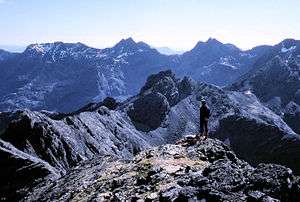Sgùrr Dearg
Sgùrr Dearg (Scottish Gaelic for '"red peak"') is a mountain in the Cuillin on the Isle of Skye, Scotland. It is topped by the Inaccessible Pinnacle (colloquially referred to by mountaineers as the In Pin or In Pinn), a fin of rock measuring 50 metres (150 feet) along its longest edge. The top of the Inaccessible Pinnacle, which at 985.8 m (3,234 ft) is the highest point of Sgùrr Dearg and the only Munro with a peak that can only be reached by rock climbing. This makes it the biggest hurdle for many Munro baggers.
| Sgùrr Dearg | |
|---|---|
| Inaccessible Pinnacle | |
 Sgùrr Dearg and the Inaccessible Pinnacle | |
| Highest point | |
| Elevation | 985.8 m (3,234 ft) [1] |
| Prominence | 187 m |
| Parent peak | Sgùrr Alasdair |
| Listing | Munro, Marilyn |
| Naming | |
| English translation | Red peak |
| Language of name | Gaelic |
| Pronunciation | Scottish Gaelic: [ˈs̪kuːrˠ ˈtʲɛɾɛk] |
| Geography | |
| Location | Skye, Scotland |
| Parent range | Cuillin |
| OS grid | NG444215 |
| Topo map | OS Landranger 32 |
| Climbing | |
| First ascent | 1880, by Charles and Lawrence Pilkington |
| Easiest route | rock climb (Moderate) |
First climbed by Charles and Lawrence Pilkington in 1880, the Pinnacle was never climbed by Sir Hugh Munro himself. Because of its status as the most difficult of the Munros it has now spawned a cottage industry for the local guides, who are frequently to be seen escorting parties of novice climbers. Unlike much of the Cuillin, the pinnacle is basalt not gabbro and thus is somewhat slippery in the wet.
Geography
Sgùrr Dearg lies on the main Cuillin ridge at the junction of Coire Lagan, Coire na Banachdich and Coir'-uisg. It is the second highest peak in the Cuillin, and faces the highest, Sgùrr Alasdair, across Coire Lagan.
Although the name Sgùrr Dearg refers to the mountain as a whole, references to the "summit" of Sgùrr Dearg are, unless otherwise qualified, generally taken to indicate the 978 metre top immediately below the Inaccessible Pinnacle on the north-western side.[2] For reasons that remain unclear, this summit was listed as a Munro in the first (1891) edition of Munro's Tables, while the higher Pinnacle was listed as a subsidiary top; this situation was reversed in the first revision of the tables in 1921.[3] Below the Inaccessible Pinnacle to the east is a smaller pinnacle called An Stac (954 m); this name originally applied to the 'In Pin' itself, and appears to have been transferred to the smaller top in error.
Ascents

Approach
While the Inaccessible Pinnacle is the hardest of the Cuillin's summits to reach, the approach to its base is relatively simple by Cuillin standards. Most walkers and climbers start from Glen Brittle, from where the easiest route involves following the faint path to the Bealach Coire na Banachdich via the corrie of the same name; from here the top of Sgùrr Dearg may be gained via a tedious scree slope interspersed with some easy scrambling. A more interesting ascent may be achieved by ascending the screes of Sron Dearg, which leads to Sgùrr Dearg's narrow and rocky south-west ridge, a grade 1/2 scramble.
Many climbers tackle the mountain as part of a circuit of the Coire Lagan skyline, or a traverse of the main Cuillin ridge, approaching it along the ridge from Sgùrr MhicChoinnich to the south-east (Grade 2). In this case the top of Sgùrr Dearg can be reached direct by scrambling up the broad flank to the left of An Stac and the Inaccessible Pinnacle.
The Inaccessible Pinnacle
The Inaccessible Pinnacle was first climbed in 1880 by a pair of Lancashire brothers, Charles and Lawrence Pilkington. They were guided to the foot of the climb from Sligachan via Coruisk and Bealach Coire na Banachdich by a local shepherd called John Mackenzie. They climbed it by the east ridge, and had to throw down a lot of loose rock as they climbed.[4]
The usual ascent of the Inaccessible Pinnacle itself is by its long east ridge, a climb of 50 metres vertically involving two roped 30 m pitches. Although graded Moderate (the lowest grade now in use in the British grading system), with good holds, the ridge is narrow and exceptionally exposed. This route was described by an early climber as "a knife-edged ridge, with an overhanging and infinite drop on one side, and a drop on the other side even steeper and longer".[5] Some climbers prefer to tackle the much shorter west ridge (20 m), graded Very Difficult. It is usual to descend from the summit of the Pinnacle by abseiling off the west end, and a permanent anchor is sited on the summit for this purpose.
In 2014 cyclist Danny MacAskill climbed Sgùrr Dearg without safety ropes, while carrying a mountain bike on his back.[6] The film was viewed over fourteen million times in the week following its launch on 2 October 2014[7] and has been watched over 63.4 million times (as of June 2019).
See also
Notes
- "Inaccessible Pinnacle (Sgùrr Dearg)". Hill Bagging - the online version of the Database of British and Irish Hills (DoBIH). 2019. Retrieved 19 June 2019.
- For example, Noel Williams states that the Pinnacle "outstrips Sgùrr Dearg by 8m and must therefore be regarded as the true summit of the mountain". Skye Scrambles, p. 163.
- The Munros and Tops 1891-1997. Spreadsheet with details of revisions to Munro's Tables.
- Williams, Noel. Skye Scrambles. Scottish Mountaineering Trust, 2000, pp.32-33
- Quoted in Murray, W.H. (1997) [1947]. Mountaineering in Scotland. Baton Wicks. ISBN 1-898573-23-9.
- https://www.youtube.com/watch?v=xQ_IQS3VKjA
References
Williams, Noel (2000). Skye Scrambles. Scottish Mountaineering Trust. ISBN 0-907521-55-X.
External links
- Sgùrr Dearg & In Pinn - details of route of ascent including free downloadable OS map.
- "Seachd - The Inaccessible Pinnacle" - official site of the film, featuring the mountain

